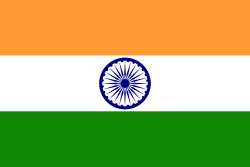Darjeeling Himalayan Railway
| Darjeeling Himalayan Railway | |
|---|---|
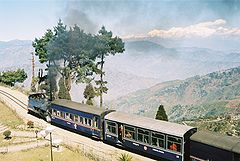 |
|
| Locomotive No. DHR 780 on Batasia Loop | |
| Locale | |
| Terminus | Darjeeling |
| Commercial operations | |
| Name | Darjeeling Himalayan Railway |
| Original gauge | 2 ft (610 mm) |
| Preserved operations | |
| Operated by | Indian Railways, supported by Darjeeling Himalayan Railway Society |
| Stations | 17 and 15 halts |
| Length | 86 kilometres (53 mi) |
| Preserved gauge | 2 ft (610 mm) |
| Commercial history | |
| Preservation history | |
The Darjeeling Himalayan Railway, nicknamed the "Toy Train", is a 2 ft (610 mm) narrow-gauge railway from Siliguri to Darjeeling in West Bengal, run by the Indian Railways.
It was built between 1879 and 1881 and is about 86 kilometres (53 mi) long. The elevation level is from about 100 m (328 ft) at Siliguri to about 2,200 metres (7,218 ft) at Darjeeling. It is still powered by steam locomotives. Modern diesel engines are used for Darjeeling’s mail train.
Since 1999 the train has been a World Heritage Site as listed by UNESCO. In 2005, UNESCO added the Nilgiri Mountain Railway as an extension to the original designation.
Contents |
History
A standard gauge railway connected Calcutta (now Kolkata) and Siliguri in 1878.[1] Siliguri, at the base of the Himalayas, was connected to Darjeeling by a cart road (the present day Hill Cart Road) on which "Tonga services" (carriage services) were available.[2] Franklin Prestage, an agent of Eastern Bengal Railway Company approached the government with a proposal of laying a steam tramway from Siliguri to Darjeeling.[2] The proposal was accepted in 1879 following the positive report of a committee formed by Sir Ashley Eden, the Lieutenant Governor of Bengal.[2] Construction started the same year.
Gillanders Arbuthnot & Co. constructed the railway. The stretch from Siliguri to Kurseong was opened on 23 August 1880, while the official opening of the line up to Darjeeling was on 4 July 1881.[1] Several engineering adjustments were made later in order to ease the gradient of the rails.[2][3] Despite natural calamities such as an earthquake in 1897 and a major cyclone in 1899[3] the DHR continued to improve with new extension lines being built in response to growing passenger and freight traffic.[3] However, the DHR started to face competition from bus services that started operating over the Hill Cart Road, offering a shorter journey time. During World War 2, the DHR played a vital role transporting military personnel and supplies to the numerous camps around Ghum and Darjeeling.[3]
After the independence of India, the DHR was absorbed into Indian Railways and became a part of the Northeast Frontier Railway zone in 1958.[3] In 1962, the line was realigned at Siliguri and extended by nearly 4 miles (6 km) to New Jalpaiguri (NJP) to meet the new broad gauge line there. DHR remained closed for 18 months during the hostile period of Gorkhaland Movement in 1988–1989.[3] DHR was declared a World Heritage Site by UNESCO in 1999, only the second railway to have this honour bestowed upon it,[4] the first one being Semmering Railway of Austria in 1998.
The route

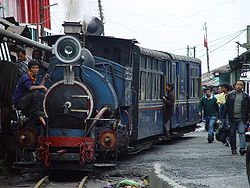
- New Jalpaiguri - the railway was extended to the south in 1964 to meet the new Broad gauge to Assam. Where the two met, New Jalpaiguri was created.
- Siliguri Town - original southern terminus of the line.
- Siliguri Junction - became a major station only when a new metre-gauge line was built to Assam in the early 1950s
- Sukna - this station marks the change in the landscape from the flat plains to the wooded lower slopes of the mountains. The gradient of the railway changes dramatically.
Loop No.1 was in the woods above Sukna. It was removed after flood damage in 1991. The site is now lost in the forest.
- Rangtong
A short distance above Rangtong there is a water tank. This was a better position for the tank than in the station, both in terms of water supply and distance between other water tanks.
When Loop 2 was removed in 1942, again following flood damage, a new reverse, No.1, was added, creating the longest reverse run.
Loop No.3 is at Chunbatti. This is now the lowest loop.
Reverses No.2 & 3 are between Chunbatti and Tindharia.
- Tindharia - this is a major station on the line as below the station is the workshops. There is also an office for the engineers and a large locomotive shed, all on a separate site.
Immediately above the station are three sidings; these were used to inspect the carriage while the locomotive was changed, before the train continued towards Darjeeling.
Agony Point is the name given to loop No.4. It comes from the shape of the loop which comes to an apex which is the tightest curve on the line.
- Gayabari
Reverse No.6 is the last reverse on the climb.
- Mahanadi
- Kurseong - There is a shed here and a few sidings adjacent to the main line, but the station proper is a dead end. Up trains must reverse out of the station (across a busy road junction) before they can continue on their climb. It is said that the station was built this way so that the train could enter a secure yard and stay there while the passengers left the train for refreshments.
Above Kurseong station, the railway runs through the bazaar. Trains skirt the front of shops and market stalls on this busy stretch of road.
- Tung
- Dilaram
- Sonada
- Rangbul
- Jor Bungalow
- Ghum - Summit of the line and highest station in India. Now includes a museum on the first floor of the station building with larger exhibits in the old goods yard.
Batasia Loop
- Darjeeling
The furthest reach of the line was to Darjeeling Bazaar, a goods-only line and now lost under the road surface and small buildings.

Locomotives
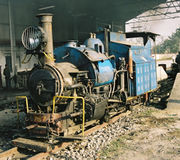

All the steam locomotives currently in use on the railway are of the 'B' Class, a design built between 1889 and 1925. A total of 34 were built but by 2005 only 12 remained on the railway and in use (or under repair).
No.787 has been rebuilt with oil firing. This was originally installed to work on the same principle as that used on Nilgiri Mountain Railway No.37395. To operate the oil burner and an electrically driven feed pump, a diesel-powered generator was fitted, and to power the braking system, a diesel-powered compressor was fitted. Additionally the locomotive was fitted with a feedwater heater. The overall result was a dramatic change in the appearance of the locomotive.
In March 2001, No.794 was transferred to the Matheran Hill Railway to allow a 'Joy Train'[5] (Steam-hauled tourist train) to be operated on that railway. It did not, however, enter service there until May 2002.
Only one DHR steam locomotive has been taken out of India, No.778 (originally No.19). After many years out of use in an American museum, it was sold to an enthusiast in the UK and restored to working order. It is now based on a private railway in Oxfordshire but has run on the Ffestiniog Railway.
Two diesel locomotives are in use, Nos.604 & 605. They are both members of the NDM6 class. Both were originally intended for use on the Matheran Hill Railway and are identical to the four locomotives actually delivered there.
In 1910 the railway purchased the third Garratt locomotive built, a D class 0-4-0+0-4-0.
In popular culture
The Darjeeling Himalayan Railway has long been viewed with affection and enthusiasm by travellers to the region, and the Earl of Ronaldshay gave the following description of a journey in the early 1920s:
"Siliguri is palpably a place of meeting.[.....] The discovery that here the metre gauge system ends and the two foot gauge of the Darjeeling-Himalayan railway begins, confirms what all these things hint at.[....]One steps into a railway carriage which might easily be mistaken for a toy, and the whimsical idea seizes hold of one that one has accidentally stumbled into Lilliput. With a noisy fuss out of all proportion to its size the engine gives a jerk - and starts.[....] No special mechanical device such as a rack is employed - unless, indeed, one can so describe the squat and stolid hill-man who sits perched over the forward buffers of the engine and scatters sand on the rails when the wheels of the engine lose their grip of the metals and race, with the noise of a giant spring running down when the control has been removed. Sometimes we cross our own track after completing the circuit of a cone, at others we zigzag backwards and forwards; but always we climb at a steady gradient - so steady that if one embarks in a trolley at Ghum, the highest point on the line, the initial push supplies all the energy necessary to carry one to the bottom."[6]
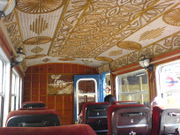
The trip up to Darjeeling on railway has changed little since that time, and continues to delight travellers and rail enthusiasts, so much so that it has its own preservation and support group, the Darjeeling Himalayan Railway Society.[7]
Several Bollywood movies have portrayed the railway. Especially popular was the song Mere sapno ki rani from the film Aradhana where the protagonist Rajesh Khanna tries to woo heroine Sharmila Tagore who was riding in the train.[8][9] Other notable films include Jhumroo, Parineeta and Raju Ban Gaya Gentleman. The Darjeeling Limited, a film directed by Wes Anderson, features a trip by three brothers on a fictional long-distance train based loosely on the Darjeeling Himalayan Railway.
In the UK, the BBC have made a series of three documentaries dealing with Indian Hill Railways http://www.bbc.co.uk/programmes/b00qzk9r of which the first deals with the Darjeeling Himalayan Railway.
Other tourist trains in India
- Palace on Wheels
- Royal Rajasthan on Wheels
- The Golden Chariot
- Deccan Odyssey
- India on Wheels
- The Indian Maharaja
See also
Notes
- ↑ 1.0 1.1 "DHR and Its Development". About DHR,dhr.in. Darjeeling Himalayan Railway, NF Railway, India. http://www.dhr.in/. Retrieved 2007-02-24.
- ↑ 2.0 2.1 2.2 2.3 "DHR History". darjeelingnews.net. Darjeelingnews. http://www.darjeelingnews.net/darjeeling_himalayan_railway.html. Retrieved 2007-02-24.
- ↑ 3.0 3.1 3.2 3.3 3.4 3.5 Whittle, Paul; Terry Martin. "A Brief History of the DHR". History and A Trip Up the Line. Darjeeling Himalayan Railway Society. http://www.dhrs.org/home.htm. Retrieved 2007-02-24.
- ↑ "Mountain Railways of India". UNESCO World Heritage Centre. http://whc.unesco.org/en/list/944. Retrieved 2006-04-30.
- ↑ "Darjeeling Himalayan Railway". Hill Railways. Indian Railways Fan Club. http://www.irfca.org/faq/faq-seltrain.html. Retrieved 2008-09-03.
- ↑ The Earl of Ronaldshay Lands of the Thunderbolt. Sikhim, Chumbi and Bhutan (London: Constable & Company) 1923 pp10-12
- ↑ "Welcome to the DHRS". Darjeeling Himalayan Railway Society. http://www.dhrs.org/home.htm. Retrieved 2007-03-09.
- ↑ Mahalingam, Sudha (March 2001). "Darjeeling: Where the journey is the destination". Travelogues. Outlook Traveller.. Outlook Publishing (India) Private Limited. http://www.outlooktraveller.com/aspscripts/travelogue.asp?dest=Darjeeling. Retrieved 2007-03-09.
- ↑ "Darjeeling Toy Train". Theme India: Train Tourism in India. IndiaLine. http://www.indialine.com/travel/trains/darjeeling-toy-train.html. Retrieved 2007-03-09.
External links
|
|||||||||||||||||||||||
|
||||||||||||||||||||||||||
